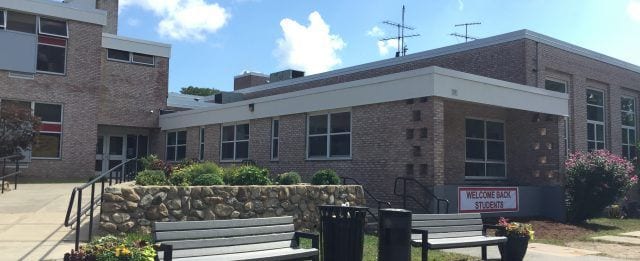
October 12, 2022 by Carol Britton Meyer
In response to the School Committee’s request for information concerning what would happen if the proposed new Foster School building project did not move forward at the Nov. 1 Special Town Meeting and subsequent Nov. 8 ballot box, Supt. of Schools Dr. Margaret Adams outlined possible courses of action and a related timeline for implementation -- and the full closure of Foster School over time -- Tuesday night.
Adams emphasized the importance of taking a cautious approach as part of a "thoughtful, planned-out process," noting that "these are just ideas. I did my best thinking about [how we might proceed]."
Possibilities include redistricting from four to three elementary schools using modular classrooms and consideration of a possible reconfiguration of grades K-12. Designated art, music, Spanish, and digital literacy space could be repurposed in all three schools to meet space needs, with instruction provided instead in the general education classroom by teachers traveling from room to room.
Adams noted that with modular classrooms carrying a high price tag and considering their much shorter period of use than an actual building, this would not be a long-term solution.
All this said, nothing has yet been determined should the project not gain the necessary voter approval.
The potential scenarios outlined by Adams relate to meeting the needs of the students served by Foster School, and any decisions would be made "in close consultation with a variety of stakeholders and a thorough planning and study process," she said.
Four possible courses of action are possible: move Foster students to another existing non-school building in Hingham, which she said would be unlikely because this would not represent a long-term solution; invest in a remodeling of the existing Foster School building, which she noted the School Building Committee has already said was not plausible because of the age of the heating and cooling systems and other major deficiencies; redistricting from four to three elementary schools, using modular classrooms; or redistricting with students divided among the three elementary schools while also considering a reconfiguration of grades --K-4, 5-7, and 8-12.
"The most plausible next course of action would be to redistrict all elementary students from four to three," Adams explained. She went on to outline a potential plan calling for a phasing out of Foster School over three years -- the estimated length of time it would take to put a redistricting plan in place if necessary.
The plan would be revised or accelerated depending on the ability to maintain the current Foster School building and to secure funding for the building of modular classrooms, according to Adams.
The Hingham Public Schools district would need to review possible plans with a variety of stakeholders to further refine actions and to develop a timeline.
Adams shared the following timeline with the School Committee:
SY 2023-2024
All kindergarten students would be redistricted to attend only three elementary schools. Every effort would be made for kindergarten students to remain with siblings. However, such determination would be based on space considerations. All entering new students in grades 1-5 would attend new attendance zones. The current Foster School building would continue to house students in grades 1-5.
SY 2024-2025
All kindergarten and grades K-1 students would attend schools as outlined by new attendance zones. The current Foster School building would continue to house students in grades 2-4.
SY 2025-2026
All kindergarten and grades K-2 students would attend schools as outlined by new attendance zones. The current Foster School building would house students in grades 3-5.
SY 2026-2027
The current Foster building would be closed following the redistricting of all new K-5 students. The current Foster students in grades 4-5 would need to be relocated. The following options could be considered at that time:
* Move grades 4-5 to a temporary space leased by the district for that short-term purpose.
* Move grades 4-5 to the middle school on a temporary basis. Classroom space would need to be identified for this purpose. This might include the use of elective classroom spaces. Those classroom teachers would be required to become traveling teachers.
Facilities Planning
Significant facilities planning would need to occur to support the redistricting of students from four elementary schools to three, Adams said.
All spaces at East, Plymouth River, and South dedicated to art, music, Spanish, and digital literacy would be repurposed to accommodate general education classroom spaces that would be needed. "These programs would move to serve students in their general education classrooms, and teachers would provide instruction in the students’ classrooms by traveling from room to room," Adams explained.
Additionally, spaces dedicated to special education or other small group instruction would need to be reviewed. Spaces that are full classrooms may need to be consolidated in order to provide space for general education classrooms.
The district would also be required to outfit each school with additional spaces to accommodate students. This might include the building of modular classrooms at East, Plymouth River, and South schools.
Finances
The district would need to ask Town Meeting for additional funding for contingency funds for emergency repairs to Foster School "in order to maintain the current building for the three years needed for the phasing out of the existing building," Adams said. "Additional funding would be needed to support the needed renovation to existing spaces."
Transportation
Since many Foster students are walkers, redistricting them to other schools would likely require increased transportation costs and additional buses and drivers.
If the project does not move forward, Adams said, "We would be looking at significant changes in how we would be delivering education services [to our students]."
School Committee Chair Michelle Ayer said that "the takeaway" from all this information is that "it will be costly," whether a new school or implementation of a contingency plan is the end result. "This is not a Foster School issue only. It would impact everyone in the district."
While acknowledging that bringing a new Foster School to reality would be a time-consuming process, School Committee member Matt Cosman "moving kids to new districts" and all that would be involved would be a "dire scenario" and difficult to execute.
He also noted that it would be challenging to implement the newly completed strategic plan for Hingham Public Schools without a new Foster School and with redistricting in place.
School Committee member Kerry Ni noted that if the project does not move forward, the town would lose an expected $25 million in Massachusetts School Building Authority funding.

